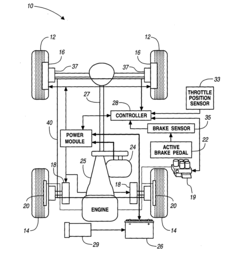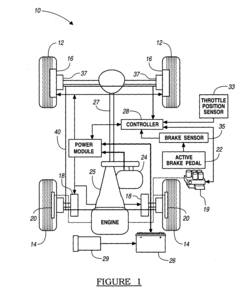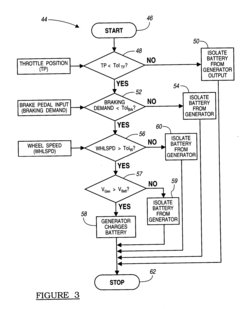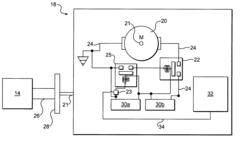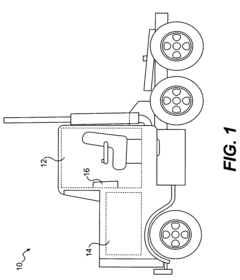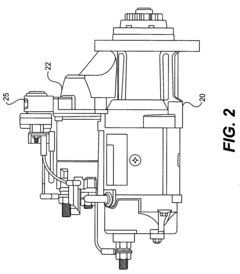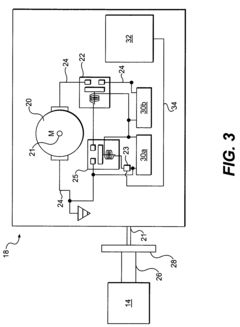How to Maximize K24 Engine Power Output with Bolt-Ons?
JUL 3, 20259 MIN READ
Generate Your Research Report Instantly with AI Agent
Patsnap Eureka helps you evaluate technical feasibility & market potential.
K24 Engine Evolution
The K24 engine, a cornerstone of Honda's performance lineup, has undergone significant evolution since its introduction in 2001. Initially designed for the Honda Accord, this 2.4-liter inline-four engine quickly gained popularity among enthusiasts for its robust design and tuning potential. The K24's journey began with the K24A1 variant, which produced a modest 160 horsepower and 161 lb-ft of torque.
As market demands shifted and technology advanced, Honda continuously refined the K24 platform. The introduction of the K24A2 in 2004 marked a notable improvement, featuring a higher compression ratio and revised camshaft profiles, resulting in increased power output. This iteration became a favorite among tuners due to its enhanced performance characteristics and compatibility with aftermarket parts.
The evolution continued with the K24A3 and K24A4 variants, which incorporated further refinements in valve timing and intake systems. These improvements not only boosted stock performance but also laid the groundwork for even greater potential when combined with aftermarket modifications. The K24Z series, introduced in the late 2000s, represented a significant leap forward, featuring a die-cast aluminum block with fiber-reinforced metal cylinder liners and a more advanced i-VTEC system.
Perhaps the most celebrated iteration came with the K24Z7, found in the 9th generation Civic Si. This variant showcased Honda's commitment to balancing performance and efficiency, producing 201 horsepower while maintaining excellent fuel economy. The K24Z7's success in the aftermarket scene further cemented the K24's reputation as a highly tunable engine platform.
Throughout its evolution, the K24 engine has consistently demonstrated its adaptability to technological advancements. The integration of direct injection in later models, such as the K24W, exemplifies Honda's ongoing efforts to improve both performance and emissions. This technological progression has not only enhanced stock performance but has also opened up new avenues for aftermarket tuning and modifications.
The K24's evolution has been characterized by incremental improvements in areas such as compression ratios, valve timing, and materials technology. These advancements have collectively contributed to increased power output, improved fuel efficiency, and enhanced durability – all critical factors for both stock performance and aftermarket potential. The engine's design philosophy has consistently emphasized a balance between high-revving performance and low-end torque, making it versatile for various applications from daily drivers to track-focused builds.
As market demands shifted and technology advanced, Honda continuously refined the K24 platform. The introduction of the K24A2 in 2004 marked a notable improvement, featuring a higher compression ratio and revised camshaft profiles, resulting in increased power output. This iteration became a favorite among tuners due to its enhanced performance characteristics and compatibility with aftermarket parts.
The evolution continued with the K24A3 and K24A4 variants, which incorporated further refinements in valve timing and intake systems. These improvements not only boosted stock performance but also laid the groundwork for even greater potential when combined with aftermarket modifications. The K24Z series, introduced in the late 2000s, represented a significant leap forward, featuring a die-cast aluminum block with fiber-reinforced metal cylinder liners and a more advanced i-VTEC system.
Perhaps the most celebrated iteration came with the K24Z7, found in the 9th generation Civic Si. This variant showcased Honda's commitment to balancing performance and efficiency, producing 201 horsepower while maintaining excellent fuel economy. The K24Z7's success in the aftermarket scene further cemented the K24's reputation as a highly tunable engine platform.
Throughout its evolution, the K24 engine has consistently demonstrated its adaptability to technological advancements. The integration of direct injection in later models, such as the K24W, exemplifies Honda's ongoing efforts to improve both performance and emissions. This technological progression has not only enhanced stock performance but has also opened up new avenues for aftermarket tuning and modifications.
The K24's evolution has been characterized by incremental improvements in areas such as compression ratios, valve timing, and materials technology. These advancements have collectively contributed to increased power output, improved fuel efficiency, and enhanced durability – all critical factors for both stock performance and aftermarket potential. The engine's design philosophy has consistently emphasized a balance between high-revving performance and low-end torque, making it versatile for various applications from daily drivers to track-focused builds.
Market for K24 Upgrades
The market for K24 engine upgrades has experienced significant growth in recent years, driven by the increasing popularity of Honda and Acura vehicles equipped with this powerplant. The K24 engine, known for its reliability and potential for modification, has become a favorite among automotive enthusiasts seeking to enhance their vehicle's performance.
The demand for K24 upgrades spans across various segments, including street performance, track day enthusiasts, and competitive racing. This diverse market has led to the development of a wide range of bolt-on modifications designed to maximize power output. These upgrades cater to different budgets and performance goals, from entry-level enthusiasts to hardcore racers.
One of the primary drivers of market growth is the aftermarket parts industry. Manufacturers have recognized the potential of the K24 platform and have invested heavily in research and development to create high-quality, performance-enhancing components. This has resulted in a robust ecosystem of bolt-on upgrades, including cold air intakes, exhaust systems, camshafts, and engine management solutions.
The market for K24 upgrades has also been bolstered by the rise of online communities and social media platforms dedicated to Honda and Acura performance. These forums and groups serve as hubs for information exchange, product reviews, and showcasing modified vehicles, further fueling interest and demand for K24 enhancements.
Geographically, the market for K24 upgrades is particularly strong in North America, Japan, and parts of Europe, where Honda and Acura vehicles are popular. However, the global nature of automotive enthusiasm has led to a growing market in other regions as well, supported by international shipping and online retail channels.
The competitive landscape of the K24 upgrade market is characterized by a mix of established aftermarket brands and smaller, specialized manufacturers. This diversity has led to a wide range of product offerings and price points, catering to various consumer preferences and budgets. The market has also seen an increase in direct-to-consumer sales models, allowing smaller manufacturers to compete with larger, more established brands.
Looking ahead, the market for K24 upgrades is expected to continue its growth trajectory. Factors contributing to this outlook include the ongoing popularity of Honda and Acura vehicles, the increasing accessibility of performance modifications, and the growing trend of vehicle personalization among younger enthusiasts. Additionally, advancements in manufacturing technologies and materials are likely to lead to more innovative and effective bolt-on solutions, further driving market expansion and consumer interest in maximizing K24 engine power output.
The demand for K24 upgrades spans across various segments, including street performance, track day enthusiasts, and competitive racing. This diverse market has led to the development of a wide range of bolt-on modifications designed to maximize power output. These upgrades cater to different budgets and performance goals, from entry-level enthusiasts to hardcore racers.
One of the primary drivers of market growth is the aftermarket parts industry. Manufacturers have recognized the potential of the K24 platform and have invested heavily in research and development to create high-quality, performance-enhancing components. This has resulted in a robust ecosystem of bolt-on upgrades, including cold air intakes, exhaust systems, camshafts, and engine management solutions.
The market for K24 upgrades has also been bolstered by the rise of online communities and social media platforms dedicated to Honda and Acura performance. These forums and groups serve as hubs for information exchange, product reviews, and showcasing modified vehicles, further fueling interest and demand for K24 enhancements.
Geographically, the market for K24 upgrades is particularly strong in North America, Japan, and parts of Europe, where Honda and Acura vehicles are popular. However, the global nature of automotive enthusiasm has led to a growing market in other regions as well, supported by international shipping and online retail channels.
The competitive landscape of the K24 upgrade market is characterized by a mix of established aftermarket brands and smaller, specialized manufacturers. This diversity has led to a wide range of product offerings and price points, catering to various consumer preferences and budgets. The market has also seen an increase in direct-to-consumer sales models, allowing smaller manufacturers to compete with larger, more established brands.
Looking ahead, the market for K24 upgrades is expected to continue its growth trajectory. Factors contributing to this outlook include the ongoing popularity of Honda and Acura vehicles, the increasing accessibility of performance modifications, and the growing trend of vehicle personalization among younger enthusiasts. Additionally, advancements in manufacturing technologies and materials are likely to lead to more innovative and effective bolt-on solutions, further driving market expansion and consumer interest in maximizing K24 engine power output.
K24 Power Limitations
The K24 engine, renowned for its reliability and versatility, faces several inherent limitations when it comes to maximizing power output through bolt-on modifications. One of the primary constraints is the engine's stock compression ratio, typically ranging from 9.7:1 to 11:1 depending on the specific K24 variant. While this compression ratio provides a good balance between performance and fuel efficiency for stock applications, it becomes a limiting factor when pursuing significant power gains.
Another key limitation is the K24's stock intake and exhaust system design. The factory intake manifold and throttle body are optimized for daily driving and fuel economy, rather than maximum airflow at high RPMs. Similarly, the stock exhaust manifold and catalytic converter create restrictions that hinder exhaust gas flow, particularly when increasing engine output.
The K24's valve train also presents challenges when seeking substantial power increases. The stock camshafts are designed for a balance of low-end torque and mid-range power, which may not be ideal for high-performance applications. Additionally, the valve springs are not typically rated for high-RPM operation, potentially leading to valve float at elevated engine speeds.
Fuel delivery becomes a critical limitation as power output increases. The stock fuel injectors and fuel pump are sized for the engine's original power output and may become inadequate when significantly boosting performance. This can lead to lean conditions and potential engine damage if not addressed properly.
The K24's internal components, while robust for stock power levels, can become stressed under high-output scenarios. The connecting rods, in particular, are often cited as a weak point when pushing the engine beyond certain power thresholds. Piston design and material also become limiting factors, especially when considering forced induction applications.
Engine management is another crucial area of limitation. The stock ECU (Engine Control Unit) is programmed with conservative parameters to ensure reliability and emissions compliance. This can restrict the ability to optimize fuel and ignition timing for maximum power output, especially when implementing significant modifications.
Cooling system capacity is an often-overlooked limitation. As power output increases, so does heat generation. The stock radiator, water pump, and oil cooler may struggle to maintain optimal operating temperatures under high-load conditions, potentially leading to reduced performance or even engine damage.
Lastly, the transmission and drivetrain components can become limiting factors when significantly increasing engine power. The stock clutch, in manual transmission applications, may not be able to handle the increased torque output. Similarly, the transmission itself and other drivetrain components may become weak links in the power delivery chain, potentially leading to reliability issues or failure under high-stress conditions.
Another key limitation is the K24's stock intake and exhaust system design. The factory intake manifold and throttle body are optimized for daily driving and fuel economy, rather than maximum airflow at high RPMs. Similarly, the stock exhaust manifold and catalytic converter create restrictions that hinder exhaust gas flow, particularly when increasing engine output.
The K24's valve train also presents challenges when seeking substantial power increases. The stock camshafts are designed for a balance of low-end torque and mid-range power, which may not be ideal for high-performance applications. Additionally, the valve springs are not typically rated for high-RPM operation, potentially leading to valve float at elevated engine speeds.
Fuel delivery becomes a critical limitation as power output increases. The stock fuel injectors and fuel pump are sized for the engine's original power output and may become inadequate when significantly boosting performance. This can lead to lean conditions and potential engine damage if not addressed properly.
The K24's internal components, while robust for stock power levels, can become stressed under high-output scenarios. The connecting rods, in particular, are often cited as a weak point when pushing the engine beyond certain power thresholds. Piston design and material also become limiting factors, especially when considering forced induction applications.
Engine management is another crucial area of limitation. The stock ECU (Engine Control Unit) is programmed with conservative parameters to ensure reliability and emissions compliance. This can restrict the ability to optimize fuel and ignition timing for maximum power output, especially when implementing significant modifications.
Cooling system capacity is an often-overlooked limitation. As power output increases, so does heat generation. The stock radiator, water pump, and oil cooler may struggle to maintain optimal operating temperatures under high-load conditions, potentially leading to reduced performance or even engine damage.
Lastly, the transmission and drivetrain components can become limiting factors when significantly increasing engine power. The stock clutch, in manual transmission applications, may not be able to handle the increased torque output. Similarly, the transmission itself and other drivetrain components may become weak links in the power delivery chain, potentially leading to reliability issues or failure under high-stress conditions.
Popular K24 Bolt-Ons
01 Engine control systems for optimizing power output
Advanced control systems are implemented to optimize the K24 engine's power output. These systems utilize various sensors and algorithms to adjust fuel injection, ignition timing, and valve timing in real-time, ensuring maximum efficiency and power across different operating conditions.- Engine control systems for optimizing power output: Advanced control systems are implemented to optimize the K24 engine's power output. These systems monitor various parameters such as fuel injection, ignition timing, and valve timing to ensure maximum efficiency and performance. By adjusting these factors in real-time, the engine can achieve optimal power output under different operating conditions.
- Turbocharging and supercharging for increased power: Forced induction methods like turbocharging or supercharging are employed to enhance the K24 engine's power output. These systems increase the amount of air entering the combustion chamber, allowing for more fuel to be burned and resulting in higher power output. Various designs and configurations of turbochargers or superchargers can be used to achieve different power levels and response characteristics.
- Variable valve timing and lift systems: Implementation of variable valve timing and lift systems in the K24 engine allows for improved power output across a wide range of engine speeds. These systems can adjust the timing and lift of the intake and exhaust valves to optimize airflow into and out of the cylinders, resulting in better volumetric efficiency and increased power output.
- Fuel injection and combustion optimization: Advanced fuel injection systems and combustion chamber designs are utilized to enhance the K24 engine's power output. Direct injection technology, coupled with optimized injector placement and spray patterns, allows for more precise fuel delivery and improved combustion efficiency. This results in increased power output and better fuel economy.
- Lightweight materials and design optimization: The use of lightweight materials and optimized component designs contributes to improved power-to-weight ratio in the K24 engine. Advanced materials such as aluminum alloys or composites are employed for engine components, reducing overall weight while maintaining strength. Additionally, computer-aided design and simulation techniques are used to optimize component shapes and reduce friction, resulting in increased power output.
02 Turbocharging and supercharging for increased power
Forced induction methods such as turbocharging and supercharging are employed to enhance the K24 engine's power output. These systems compress the intake air, allowing more fuel to be burned and resulting in increased horsepower and torque across the engine's rev range.Expand Specific Solutions03 Variable valve timing and lift systems
The K24 engine incorporates advanced variable valve timing and lift systems to optimize airflow and combustion efficiency. These systems adjust valve operation based on engine speed and load, improving power output, fuel economy, and emissions performance across a wide range of operating conditions.Expand Specific Solutions04 Engine management and performance tuning
Sophisticated engine management systems and performance tuning techniques are utilized to maximize the K24 engine's power output. These include adjustments to fuel maps, ignition timing, and other parameters to extract optimal performance while maintaining reliability and emissions compliance.Expand Specific Solutions05 Materials and design optimization for increased power
Advanced materials and optimized component designs are employed in the K24 engine to reduce weight, improve thermal efficiency, and increase overall power output. This includes the use of lightweight alloys, improved piston and cylinder head designs, and enhanced cooling systems to support higher power levels.Expand Specific Solutions
Key Aftermarket Brands
The competition landscape for maximizing K24 engine power output with bolt-ons is characterized by a mature market with established players and ongoing innovation. The automotive aftermarket for engine performance upgrades is substantial, estimated at several billion dollars globally. Major automotive manufacturers like Honda, the original developer of the K24 engine, compete alongside specialized aftermarket parts companies. The technology is well-developed, with companies like BorgWarner and Robert Bosch GmbH offering advanced bolt-on solutions. However, there's continuous innovation in areas like turbocharging, fuel injection, and engine management systems, driving incremental performance gains. The market is competitive, with a mix of OEM and aftermarket players vying for market share in this performance-oriented niche.
BorgWarner, Inc.
Technical Solution: BorgWarner, a leading automotive supplier, has developed a range of bolt-on solutions to enhance K24 engine performance. Their approach focuses on forced induction, specifically turbocharging. BorgWarner's EFR (Engineered for Racing) series turbochargers have been adapted for the K24 engine, offering significant power gains. Their proprietary Gamma-Ti turbine wheel technology reduces inertia by up to 50% compared to traditional Inconel wheels[4], allowing for quicker spool-up times and improved throttle response. BorgWarner's advanced wastegate designs provide precise boost control, maintaining optimal performance across the engine's RPM range. They've also developed a water-cooled, ceramic ball bearing system that reduces friction by up to 70% compared to journal bearings[5], further enhancing turbocharger efficiency and longevity.
Strengths: Expertise in forced induction technology, high-quality components designed for performance applications. Weaknesses: Solutions may require significant modifications to the engine bay and supporting systems, potentially increasing complexity and cost.
General Motors LLC
Technical Solution: While not the original manufacturer of the K24 engine, General Motors has developed aftermarket performance parts that can be adapted to enhance K24 engine output. Their approach includes a combination of mechanical and electronic upgrades. GM's performance division has designed high-lift camshafts that increase valve lift by up to 20% compared to stock cams[7], improving breathing and power output across the RPM range. They've also developed lightweight, forged pistons that reduce reciprocating mass, allowing for higher RPM operation. GM's engine management solutions, while primarily designed for their own engines, have been adapted by aftermarket tuners for use with the K24, offering features like flex-fuel capability and advanced boost control for forced induction applications.
Strengths: Extensive resources for R&D, experience in high-performance engine development. Weaknesses: Solutions may require more adaptation to fit the K24 engine specifically, potentially increasing complexity of installation and tuning.
Innovative K24 Mods
Method and apparatus for power management of a regenerative braking system
PatentInactiveUS20040035656A1
Innovation
- A power management system that uses sensors to control the battery's connection to the generator, decoupling it when excess energy is generated and coupling it back when necessary, allowing efficient energy distribution and charging based on throttle, brake pedal, and wheel speed thresholds.
24-volt engine start-up system
PatentInactiveUS7986053B2
Innovation
- A 24-volt engine start-up system integrated with a 12-volt-powered magnetic switch that supplies power to a 24-volt starter motor, allowing for efficient engine cranking while maintaining compatibility with existing 12-volt electrical components.
Emissions Compliance
When maximizing the power output of the K24 engine with bolt-on modifications, emissions compliance remains a critical consideration. The K24 engine, originally designed to meet stringent emissions standards, requires careful attention to maintain its environmental performance while enhancing power.
Aftermarket modifications often impact the engine's air-fuel ratio, potentially leading to increased emissions. To address this, engine tuners must optimize the engine control unit (ECU) to maintain proper stoichiometric ratios across various operating conditions. This involves fine-tuning fuel injection timing and duration, as well as adjusting ignition timing to ensure complete combustion.
Catalytic converter upgrades play a crucial role in emissions compliance. High-flow catalytic converters can help maintain emissions standards while reducing exhaust backpressure, allowing for increased power output. These advanced catalysts often utilize precious metals like platinum and palladium in higher concentrations to effectively convert harmful exhaust gases into less harmful compounds.
Exhaust gas recirculation (EGR) systems, which help reduce nitrogen oxide emissions, may require recalibration or modification when increasing engine power. Aftermarket EGR delete kits are available but may compromise emissions compliance. Instead, upgrading to a more efficient EGR cooler can help maintain emissions control while supporting increased power output.
Cold air intake systems, while beneficial for power gains, must be designed to work in conjunction with the engine's mass airflow sensor to ensure accurate air-fuel mixture calculations. Poorly designed intakes can lead to inaccurate readings and subsequent emissions issues.
Forced induction modifications, such as turbocharging or supercharging, significantly alter the engine's operating characteristics and emissions profile. These modifications often require extensive ECU tuning and may necessitate upgraded fuel injectors and an improved fuel management system to maintain emissions compliance under higher boost pressures.
To ensure ongoing emissions compliance, regular monitoring and testing are essential. Utilizing wideband oxygen sensors and onboard diagnostic tools can help track emissions performance in real-time, allowing for prompt adjustments to maintain compliance while maximizing power output.
Ultimately, achieving maximum power output from the K24 engine with bolt-on modifications while maintaining emissions compliance requires a holistic approach. This involves careful selection of compatible aftermarket components, precise ECU tuning, and ongoing monitoring to strike the optimal balance between performance enhancement and environmental responsibility.
Aftermarket modifications often impact the engine's air-fuel ratio, potentially leading to increased emissions. To address this, engine tuners must optimize the engine control unit (ECU) to maintain proper stoichiometric ratios across various operating conditions. This involves fine-tuning fuel injection timing and duration, as well as adjusting ignition timing to ensure complete combustion.
Catalytic converter upgrades play a crucial role in emissions compliance. High-flow catalytic converters can help maintain emissions standards while reducing exhaust backpressure, allowing for increased power output. These advanced catalysts often utilize precious metals like platinum and palladium in higher concentrations to effectively convert harmful exhaust gases into less harmful compounds.
Exhaust gas recirculation (EGR) systems, which help reduce nitrogen oxide emissions, may require recalibration or modification when increasing engine power. Aftermarket EGR delete kits are available but may compromise emissions compliance. Instead, upgrading to a more efficient EGR cooler can help maintain emissions control while supporting increased power output.
Cold air intake systems, while beneficial for power gains, must be designed to work in conjunction with the engine's mass airflow sensor to ensure accurate air-fuel mixture calculations. Poorly designed intakes can lead to inaccurate readings and subsequent emissions issues.
Forced induction modifications, such as turbocharging or supercharging, significantly alter the engine's operating characteristics and emissions profile. These modifications often require extensive ECU tuning and may necessitate upgraded fuel injectors and an improved fuel management system to maintain emissions compliance under higher boost pressures.
To ensure ongoing emissions compliance, regular monitoring and testing are essential. Utilizing wideband oxygen sensors and onboard diagnostic tools can help track emissions performance in real-time, allowing for prompt adjustments to maintain compliance while maximizing power output.
Ultimately, achieving maximum power output from the K24 engine with bolt-on modifications while maintaining emissions compliance requires a holistic approach. This involves careful selection of compatible aftermarket components, precise ECU tuning, and ongoing monitoring to strike the optimal balance between performance enhancement and environmental responsibility.
Dyno Testing Methods
Dyno testing methods are crucial for accurately measuring and optimizing the power output of K24 engines with bolt-on modifications. These methods provide quantifiable data on engine performance, allowing for precise tuning and evaluation of various aftermarket components.
The most common dyno testing method for K24 engines is the chassis dynamometer, which measures power at the wheels. This approach accounts for drivetrain losses and provides a realistic representation of the engine's performance in real-world conditions. When testing K24 engines, it is essential to use a dyno capable of handling high-revving four-cylinder engines, typically with a maximum power rating of at least 400 horsepower.
To ensure accurate and repeatable results, proper dyno testing procedures must be followed. This includes allowing the engine to reach operating temperature before testing, maintaining consistent ambient conditions, and performing multiple runs to establish baseline measurements. It is also crucial to use the same gear for all tests, typically third or fourth gear, depending on the vehicle's transmission.
Data acquisition during dyno testing is equally important. Modern dynamometers use sophisticated software to record and analyze various parameters, including horsepower, torque, air/fuel ratio, and boost pressure (if applicable). This data helps identify areas for improvement and allows for real-time adjustments to engine management systems.
When testing bolt-on modifications for K24 engines, it is advisable to follow a systematic approach. This involves testing each modification individually to determine its impact on power output. Common bolt-ons for K24 engines include cold air intakes, exhaust systems, camshafts, and ECU tuning. By isolating each modification, tuners can accurately assess the performance gains and potential synergies between different components.
Dyno testing also plays a crucial role in optimizing engine tuning. With the K24 engine's versatility, proper tuning can unlock significant power gains, especially when combined with bolt-on modifications. During dyno sessions, tuners can make real-time adjustments to fuel maps, ignition timing, and other parameters to maximize power output while ensuring engine safety and reliability.
It is important to note that dyno testing results can vary depending on environmental factors such as temperature, humidity, and altitude. To account for these variables, many dyno facilities use correction factors to standardize results. This allows for more accurate comparisons between different testing sessions and locations.
In conclusion, dyno testing methods are indispensable tools for maximizing K24 engine power output with bolt-on modifications. By providing accurate performance measurements and facilitating precise tuning, dyno testing enables enthusiasts and tuners to unlock the full potential of these versatile engines while maintaining reliability and drivability.
The most common dyno testing method for K24 engines is the chassis dynamometer, which measures power at the wheels. This approach accounts for drivetrain losses and provides a realistic representation of the engine's performance in real-world conditions. When testing K24 engines, it is essential to use a dyno capable of handling high-revving four-cylinder engines, typically with a maximum power rating of at least 400 horsepower.
To ensure accurate and repeatable results, proper dyno testing procedures must be followed. This includes allowing the engine to reach operating temperature before testing, maintaining consistent ambient conditions, and performing multiple runs to establish baseline measurements. It is also crucial to use the same gear for all tests, typically third or fourth gear, depending on the vehicle's transmission.
Data acquisition during dyno testing is equally important. Modern dynamometers use sophisticated software to record and analyze various parameters, including horsepower, torque, air/fuel ratio, and boost pressure (if applicable). This data helps identify areas for improvement and allows for real-time adjustments to engine management systems.
When testing bolt-on modifications for K24 engines, it is advisable to follow a systematic approach. This involves testing each modification individually to determine its impact on power output. Common bolt-ons for K24 engines include cold air intakes, exhaust systems, camshafts, and ECU tuning. By isolating each modification, tuners can accurately assess the performance gains and potential synergies between different components.
Dyno testing also plays a crucial role in optimizing engine tuning. With the K24 engine's versatility, proper tuning can unlock significant power gains, especially when combined with bolt-on modifications. During dyno sessions, tuners can make real-time adjustments to fuel maps, ignition timing, and other parameters to maximize power output while ensuring engine safety and reliability.
It is important to note that dyno testing results can vary depending on environmental factors such as temperature, humidity, and altitude. To account for these variables, many dyno facilities use correction factors to standardize results. This allows for more accurate comparisons between different testing sessions and locations.
In conclusion, dyno testing methods are indispensable tools for maximizing K24 engine power output with bolt-on modifications. By providing accurate performance measurements and facilitating precise tuning, dyno testing enables enthusiasts and tuners to unlock the full potential of these versatile engines while maintaining reliability and drivability.
Unlock deeper insights with Patsnap Eureka Quick Research — get a full tech report to explore trends and direct your research. Try now!
Generate Your Research Report Instantly with AI Agent
Supercharge your innovation with Patsnap Eureka AI Agent Platform!
